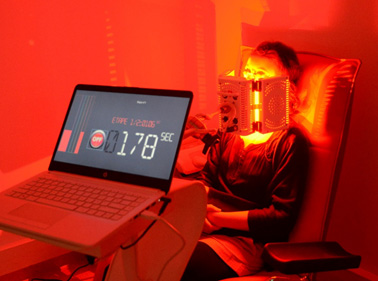Villejuif, April 11th 2023
An innovative technique to prevent and reduce some side effects of cancer treatment
Used by dentists, dermatologists, and physiotherapists, photobiomodulation or low-energy laser/LED therapy is also proving to be a valuable asset in oncology. This innovative, non-invasive, and painless technique based on light is used for its analgesic, anti-inflammatory, and healing properties. In oncology, it promotes tolerance to chemotherapy and radiotherapy treatments due to its role in the prevention or treatment of certain side effects. Photobiomodulation is currently booming thanks to recent discoveries on its cellular-level mechanisms of action and progress in setting up new devices. Gustave Roussy has just acquired a fourth photobiomodulation device.

"Photobiomodulation is a non-invasive method, with no identified side effects so far, with proven clinical results in indications that have no other therapeutic alternatives," says Dr. Camelia Billard-Sandu, medical oncologist at Gustave Roussy. The technique involves exposing cells or tissues to specific wavelength light to stimulate their activity. The wavelengths of light used in photobiomodulation, red or near-infrared, are absorbed by the mitochondria of the cells. These produce cellular energy, and stimulation of their activity by light can lead to an increase in the production of cellular fuel, adenosine triphosphate (ATP).
Developing potential in oncology
"In oncology, photobiomodulation is used to help heal damaged tissues, improve immune response, reduce inflammation, and thus prevent or treat certain side effects of conventional treatments such as chemotherapy and radiotherapy. Several international scientific societies (MASCC/ISOO or ESMO) recommend this technique in the prevention of mucositis (inflammation of the oral mucosa) induced by radiotherapy or chemotherapy in onco-hematology," explains Dr. Billard-Sandu. Other indications are emerging and are currently the subject of clinical studies for the management of: radiodermatitis (skin burns induced by radiotherapy), peripheral neuropathies induced by certain chemotherapy (tingling, pricking, or loss of sensitivity), cutaneous fibrosis (cardboard effect of the skin after radiotherapy), lymphedema (swelling of tissues), dry mouth, or trismus (constant and involuntary contraction of the muscles of the jaw).
"The ease of use of photobiomodulation devices, the very interesting clinical results of this technique in many indications will make it possible to disseminate photobiomodulation in oncology support care," adds Camelia Billard-Sandu, who is responsible for the University Diploma in Photobiomodulation in Oncology Support Care created at the University of Paris-Saclay in 2020. For the second consecutive year, a photobiomodulation seminar, open to medical and paramedical personnel, is being organized by the Cancer Sciences School in June 2023, to improve knowledge and make the technique more accessible to patients throughout the country.

